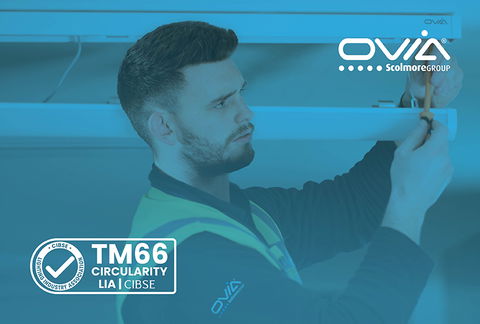The current model of product development is generally; Raw materials – Design - Production – Distribution – Consumption – Collection – Waste Management/Landfill’, or simplified to ‘Take, Make, Use, Shred/Landfill’. This model is very linear and has raised the amount of electronic waste to unsustainable levels.

The circular economy is a model of production and consumption which places the emphasis on, ‘…sharing, leasing, reusing, repairing, refurbishing and recycling existing materials and products for as long as possible’.
“Technical Memorandum 66 (TM66) – creating a circular economy in the lighting industry” published by CIBSE ‘…sets out what designing and manufacturing to comply with circular economy principles entails and includes a checklist, a method of assessing a product’s circular economy performance, and real-world examples of good practice.’
TM66 provides practical guidance to all elements of the lighting industry, including clients, manufacturers, specifiers, wholesalers, designers and the like in how they might better take account of all the factors which impact upon the Use, Re-use and Re-make of lighting products.
How is a product TM66 certified?
The Circular Economy Assessment Method (CEAM) uses two spreadsheets (‘Make’ and ‘Specify’), authored and developed by industry specialists (including the Lighting Industry Association - LIA), and are used to enable manufacturers and specifiers to assess their lighting products, and develop their systems as they work to align with the circular economy over time.
The use of CEAM is not an environmental audit. The use of CEAM guides manufacturers and others in the areas where action should/could be taken to improve their alignment with the circular economy.
CEAM incorporates a scoring system giving a clear value of where a manufacturer of lighting products stands in a circular economy environment. The table below shows the scoring system.

OVIA works hard to improve its circular economy and a range of its lighting products have been certified TM66 circularity with LIA/CIBSE in the range 1.5 – 2.5 (based on the scores in the above table).
TM66 - What’s next for the Circular Economy?
The lighting industry is at a relatively early stage of understanding and applying the principles of the circular economy and needs to work at educating the relevant sectors within the industry to grasp the challenges and benefits of the circular economy.
It is widely recognised that significant improvements in lighting efficiency have taken place with the introduction of LEDs, and progress continues to be made. However, for example, where LEDs and the like continue to be sent for disposal rather than considered for re-use or re-manufacture then the underlying principles of the circular economy are clearly not being understood and applied.
Other areas of necessary future development detailed within TM66, include environmental auditing, technical obsolescence (particularly as it relates to controls), incentives and corporate objectives and ethics and responsibilities.
Legislation, standards and the need for manufacturers to be able to design, make and sell in the UK and into the wider European and world markets, will force designers, specifiers, manufacturers and the like to positively engage with the circular economy. The use of TM66 and CEAM is a useful way in which businesses can assess where they are in terms of their direction of travel towards products being designed for use, re-use and re-making.
